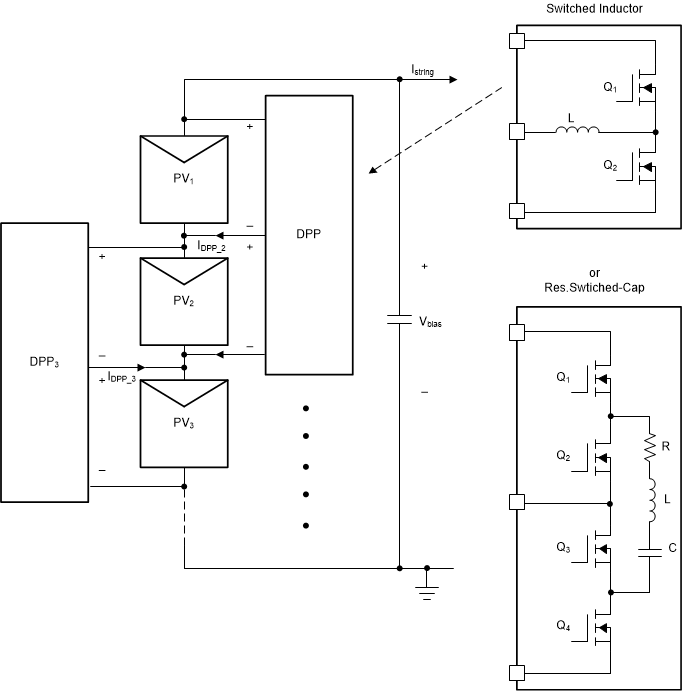SLLA498 October 2020
6.2 Differential Power Processing
In solar string inverters, individual solar panels are connected in series to get a voltage high enough to do efficient power processing. However, series strings of PV cells often experience severe power decrease when there is mismatch in the electrical characteristics of the PV cells, often caused by partial shading, panels at different tilt angles, dust accumulation, or cell degradation. Even after implementing a string-level MPPT converter, the power available may not be completely extracted. While individual power optimizers for each panel can solve this issue effectively, it has to process the entire power from the panel to which it is connected; hence called the Full Power Processing (FPP) method. This results in higher losses in conversion, and also increases cost. An alternate to this is called the Differential Power Processing (DPP) method, one type of implementation of which is shown in Figure 6-1.
 Figure 6-1 PV-PV DPP Architecture.
Figure 6-1 PV-PV DPP Architecture. In DPP converters, only the difference in power between adjacent panels needs to be processed by it. This reduces power conversion losses compared to the FPP method and also results in reduced cost of the system. There are multiple ways of implementing a DPP architecture like PV connected to bus (PV-bus), PV connected to PV (PV-PV), and PV connected to an isolated port (PV-IP). These architectures are those commonly used with active cell balancing in battery packs. PV-bus architecture is commonly used with lower string voltages. The PV-PV DPP converters have more potential for scalability than the PV-bus architecture, and hence are more suited for higher string voltages. Figure 6-1 shows the PV-PV architecture. It has the additional advantage of using only non-isolated topologies and hence are of comparatively lower cost.
The main stumbling block for acceptance of DPP is its higher cost compared to the unoptimized series string due to the increased number of components. However, The cost of DPP is lower than FPP and hence is preferable when individual panel power optimization is a requirement. Compared to FPP, the control of DPP is complex, as the MPPT algorithm needs to be a distributed one. Though it provides more watts per dollar over its lifetime compared to other architectures, the upfront cost and system complexity currently limits the use of DPP architecture in string inverters. As semiconductor technology continues to reduce the overall system cost year-over-year, there is a good chance that DPP could start becoming economically viable in the years to come.